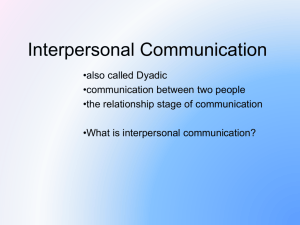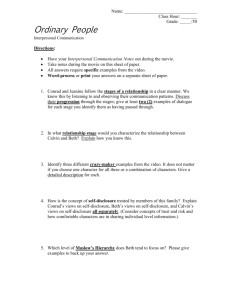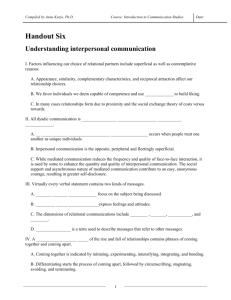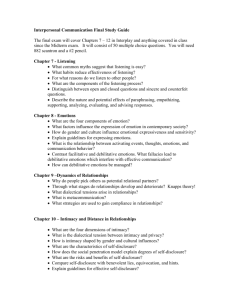Social Penetration Theory – 10/1/2013
advertisement
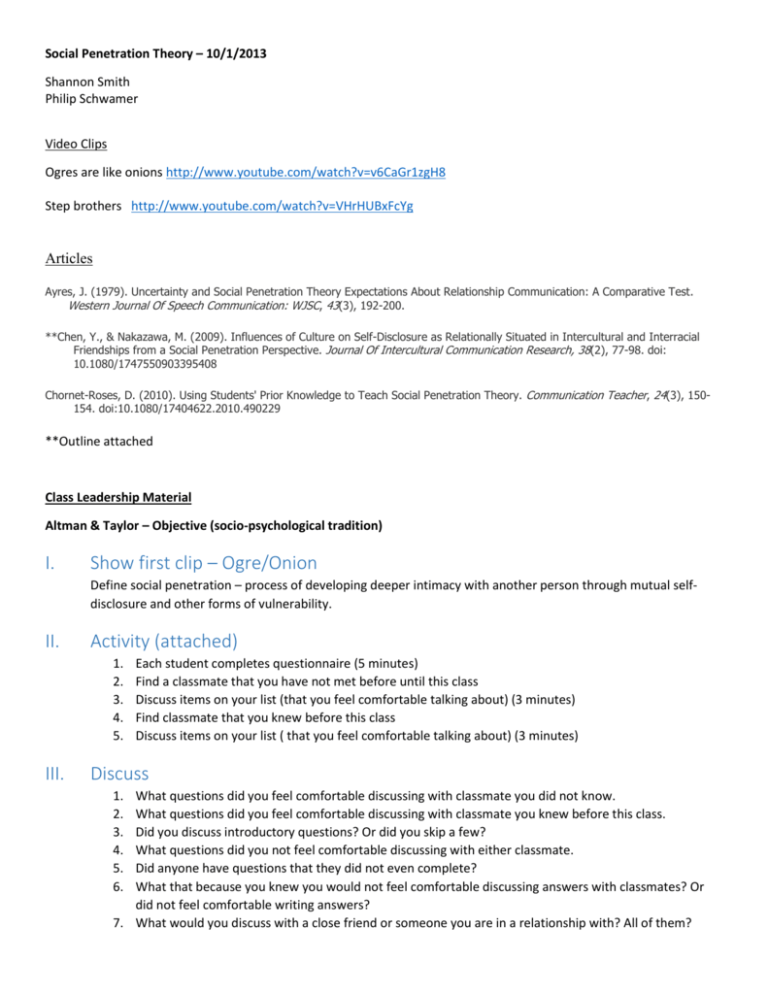
Social Penetration Theory – 10/1/2013 Shannon Smith Philip Schwamer Video Clips Ogres are like onions http://www.youtube.com/watch?v=v6CaGr1zgH8 Step brothers http://www.youtube.com/watch?v=VHrHUBxFcYg Articles Ayres, J. (1979). Uncertainty and Social Penetration Theory Expectations About Relationship Communication: A Comparative Test. Western Journal Of Speech Communication: WJSC, 43(3), 192-200. **Chen, Y., & Nakazawa, M. (2009). Influences of Culture on Self-Disclosure as Relationally Situated in Intercultural and Interracial Friendships from a Social Penetration Perspective. Journal Of Intercultural Communication Research, 38(2), 77-98. doi: 10.1080/1747550903395408 Chornet-Roses, D. (2010). Using Students' Prior Knowledge to Teach Social Penetration Theory. Communication Teacher, 24(3), 150154. doi:10.1080/17404622.2010.490229 **Outline attached Class Leadership Material Altman & Taylor – Objective (socio-psychological tradition) I. Show first clip – Ogre/Onion Define social penetration – process of developing deeper intimacy with another person through mutual selfdisclosure and other forms of vulnerability. II. Activity (attached) 1. 2. 3. 4. 5. III. Each student completes questionnaire (5 minutes) Find a classmate that you have not met before until this class Discuss items on your list (that you feel comfortable talking about) (3 minutes) Find classmate that you knew before this class Discuss items on your list ( that you feel comfortable talking about) (3 minutes) Discuss 1. 2. 3. 4. 5. 6. What questions did you feel comfortable discussing with classmate you did not know. What questions did you feel comfortable discussing with classmate you knew before this class. Did you discuss introductory questions? Or did you skip a few? What questions did you not feel comfortable discussing with either classmate. Did anyone have questions that they did not even complete? What that because you knew you would not feel comfortable discussing answers with classmates? Or did not feel comfortable writing answers? 7. What would you discuss with a close friend or someone you are in a relationship with? All of them? IV. Layers – relate to activity V. Long Term Relationships – Will we become and/or stay friends? VI. Self-Disclosure – voluntary sharing of personal history, preferences, attitudes, feelings, values, secrets, with another person; transparency. Personality structure – layers of beliefs/feelings about self, other and world; deeper layers more vulnerable, and central to self image Process of Penetration Peripheral items exchanged more freq./sooner that private info. Self-disclosure is reciprocal, esp in early stages of relationship development Penetration is rapid at start, slows quickly as inner layers reached Depenetration - gradual layer by layer withdrawal Depth of Penetration - the degree of disclosure (or intimacy) in a specific area of an individual’s life Breath of Penetration – range of areas in an individual’s life over which disclosure takes place Law of Reciprocity – paced/orderly process in which openness in one person leads to openness in the other; sharing of information Social Exchange – relationship behavior and status regulated by both parties’ evaluations of perceived rewards and costs of interaction with each other Cost benefit analysis that each man performs as he considers the possibility of a closer relationship Outcome – perceived rewards minus the costs of IP interaction Minimax principle claims that people seek to maximize their benefits and minimize their costs. The higher we rate a relational outcome, the more attractive we find the behavior that might make it happen. Comparison Level (CL) – threshold above which an IP outcome seems attractive; standard for relational satisfaction Comparison Level Of Alternatives (Clalt) – best outcome available in other relationships; a standard for relational stability Answers 2 questions: Would my relational payoffs be better with another person? What is the worst outcome I’ll put up with and still stay in the present relationship? Cannot be used to indicate relationship satisfaction, but can sometimes explain why a person stays with another. Outcome>CLalt>CL Ethical egoism – belief that individuals should live their lives so as to maximize their own pleasure and minimize their own pain. Dialectical Model Def - Assumption that people want both privacy and intimacy in their social relationships; they experience a tension between disclosure and withdrawal. Viewing increased self-disclosure as the path to intimacy Territoriality – tendency to claim a physical location or object as our own. Onion includes both social penetration of mind and physical space. VII. Critique Good model because: Established and familiar explanation of how closeness develops in ongoing relationships. Helpful model of growing intimacy Model challenges: Petronio finds it simplistic to equate self-disclosure to relational closeness. Can lead to intimacy, but person may reveal private info to express self or gain relational control. Feel our boundaries are personally created, often shifting, and frequently permeable. Reward-Cost analysis Can blend of advantages/disadvantages reduce to a single numerical index? No longer centered on personal gain: People regard good things happening to their friends as rewards to themselves. Selfless love – relational transformation, not just self-disclosure. I. Article Review – A. Overview Examine the effects of individualism-collectivism and relational intimacy on topics and dimensions of self-disclosure from a social penetration perspective. Results suggest that cultural and racial/ethnic differences hinder initiation and development of intercultural and interracial relationships. II. Use of Altman and Taylor’s SPT A. B. Provides link between self-disclosure and friendship development Goal of theory 1. 2. C. Describe course of growth or dissolution of IP relationships Look at how people enact exploration/formation of social bonds Social Penetration 1. Refers to overt and IP behaviors and assumes a) b) c) d) e) II. Process is orderly. Progresses through stages over time Relationship advancement dependent on rewards/costs Penetration/dissolution follow orderly progress from superficial to intimate or vice versa Self-disclosure is gratifying Apply to Cross Cultural/IC Relationships A. Look at IP relationships from Multiple Behavioral Perspectives 1. 2. 3. 4. B. Eight generic dimension of SPT process 1. 2. 3. 4. 5. 6. 7. 8. C. Perception Cognition Verbal/NV Levels of function Breadth Uniqueness Efficiency of Exchange Substitutability/Equivalency Synchronization/Pacing Permeability/Openness Spontaneity in Exchange Evaluation Self-Disclosure same across cultures 1. 2. Topics Dimensions III. Hypotheses and Research Question/Results A. H1: Levels of relational intimacy in intercultural and interracial friendships are positively correlated with depth and frequency of topics of self-disclosure (defined as closeness one feels/enacts towards a friend). B. H2a: As the levels of relations intimacy in intercultural and interracial friendships increase, the intercultural and interracial friends have greater intent to disclose, disclose in greater amount and depth, and engage in more negative and honest-accurate disclosure. C. H2b: Intercultural and interracial friends with greater length of friendships have greater relational intimacy, resulting in stronger relationships among relational intimacy, self-disclosure, and culture (i.e., individualism-collectivism) D. H3: The more individualistic a person is, the more s/he would self-disclose. E. RQ1: How does cultural variability of individualism-collectivism (I-C) influence dimensions of self-disclosure in intercultural and interracial friendships? IV. Procedure/Participants A. B. 300 individuals Format 1. 2. 3. 4. V. Relational/social intimacy items Self-Disclosure items Individualism/Collectivism items Demographics Instrument A. 20-25 minute questionnaire 1. 2. Independent Variables Relational Intimacy a) 3. Individualism-Collectivism a) B. 8 items used from previously validated 17 item social intimacy test 16 item scale (1) 8/individualism (2) 8/collectivism Dependent Variables 1. 6 topics self-disclosure a) 2. 30 items from 60 item validated scale/2X 5 dimensions of self-disclosure a) 20 items from 31 item validated scale VI. Results A. As levels of relations intimacy increased, self-disclosure in 6 topics increased – H1 was supported. B. Increased levels of relational intimacy did not influence positive/negative self-disclosure as predicted – H2 was mostly supported. C. The more individualistic an individual was, the more the individual would engage in selfdisclosure – H3 was not supported (amount of individualism was not related to self-disclosure) D. Individualism was correlated with intent, depth, and honesty-accuracy or self-disclosure – RQ1 was supported. E. Ones self-reported self-disclosure would mirror one’s perception of friend’s selfdisclosure – H4 was supported, correlation was significant. Chen, Y., & Nakazawa, M. (2009). Influences of Culture on Self-Disclosure as Relationally Situated in Intercultural and Interracial Friendships from a Social Penetration Perspective. Journal Of Intercultural Communication Research, 38(2), 77-98. doi: 10.1080/1747550903395408 Where are you from? What is your major? What year are you in school? Do you have any brothers/sisters? How many? What is your favorite food? What kind of music do you listen to? Where do you see yourself in 5 years? 10 years? What religion are you? Do you attend church on a regular basis? How do you feel about Obama as a president? Agree with his philosophies? What is your biggest fear? What is your greatest fantasy?
